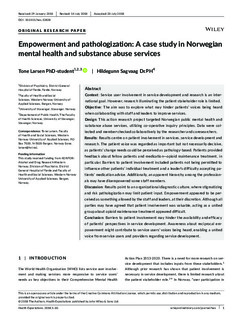| dc.contributor.author | Larsen, Tone | |
| dc.contributor.author | Sagvaag, Hildegunn | |
| dc.date.accessioned | 2018-09-06T12:07:47Z | |
| dc.date.available | 2018-09-06T12:07:47Z | |
| dc.date.created | 2018-09-04T10:53:02Z | |
| dc.date.issued | 2018-07 | |
| dc.identifier.citation | Larsen, T., Sagvaag, H. (2018) Empowerment and pathologization: A case study in Norwegian mental health and substance abuse services. Health Expectations. Health Expectations, 1-10. | nb_NO |
| dc.identifier.issn | 1369-6513 | |
| dc.identifier.uri | http://hdl.handle.net/11250/2561234 | |
| dc.description.abstract | Context: Service user involvement in service development and research is an international goal. However, research illuminating the patient stakeholder role is limited. Objective: The aim was to explore what may hinder patients’ voices being heard when collaborating with staff and leaders to improve services. Design: This action research project targeted Norwegian public mental health and substance abuse services, utilizing co-operative inquiry principles. Data were collected and member-checked collaboratively by the researcher and coresearchers. Results: Results centre on patient involvement in services, service development and research. The patient voice was regarded as important but not necessarily decisive, as patients’ change needs could be perceived as pathology-based. Patients provided feedback about fellow patients and medication—opioid maintenance treatment, in particular. Barriers to patient involvement included patients not being permitted to influence other patients’ individual treatment and a leader’s difficulty accepting patients’ medication advice. Additionally, an apparent hierarchy among the professionals may have disempowered some staff members. Discussion: Results point to an organizational diagnostic culture, where stigmatizing and risk pathologization may limit patient input. Empowerment appeared to be perceived as something allowed by the staff and leaders, at their discretion. Although all parties may have agreed that patient involvement was valuable, acting as a united group about opioid maintenance treatment appeared difficult. Conclusion: Barriers to patient involvement may hinder the availability and efficacy of patients’ perspectives in service development. Awareness about reciprocal empowerment might contribute to service users’ voices being heard, enabling a united voice from service users and providers regarding service development. | nb_NO |
| dc.language.iso | eng | nb_NO |
| dc.publisher | John Wiley & Sons Ltd. | nb_NO |
| dc.rights | Navngivelse 4.0 Internasjonal | * |
| dc.rights.uri | http://creativecommons.org/licenses/by/4.0/deed.no | * |
| dc.subject | folkehelse | nb_NO |
| dc.subject | brukermedvirkning | nb_NO |
| dc.subject | pasientmedvirkning | nb_NO |
| dc.title | Empowerment and pathologization: A case study in Norwegian mental health and substance abuse services | nb_NO |
| dc.type | Journal article | nb_NO |
| dc.type | Peer reviewed | nb_NO |
| dc.description.version | publishedVersion | nb_NO |
| dc.rights.holder | © 2018 The Authors. | nb_NO |
| dc.subject.nsi | VDP::Medical disciplines: 700::Health sciences: 800::Community medicine, Social medicine: 801 | nb_NO |
| dc.source.pagenumber | 1-10 | nb_NO |
| dc.source.journal | Health Expectations | nb_NO |
| dc.identifier.doi | 10.1111/hex.12828 | |
| dc.identifier.cristin | 1606495 | |
| cristin.unitcode | 217,13,1,0 | |
| cristin.unitname | Avdeling for folkehelse | |
| cristin.ispublished | true | |
| cristin.fulltext | original | |
| cristin.qualitycode | 1 | |

